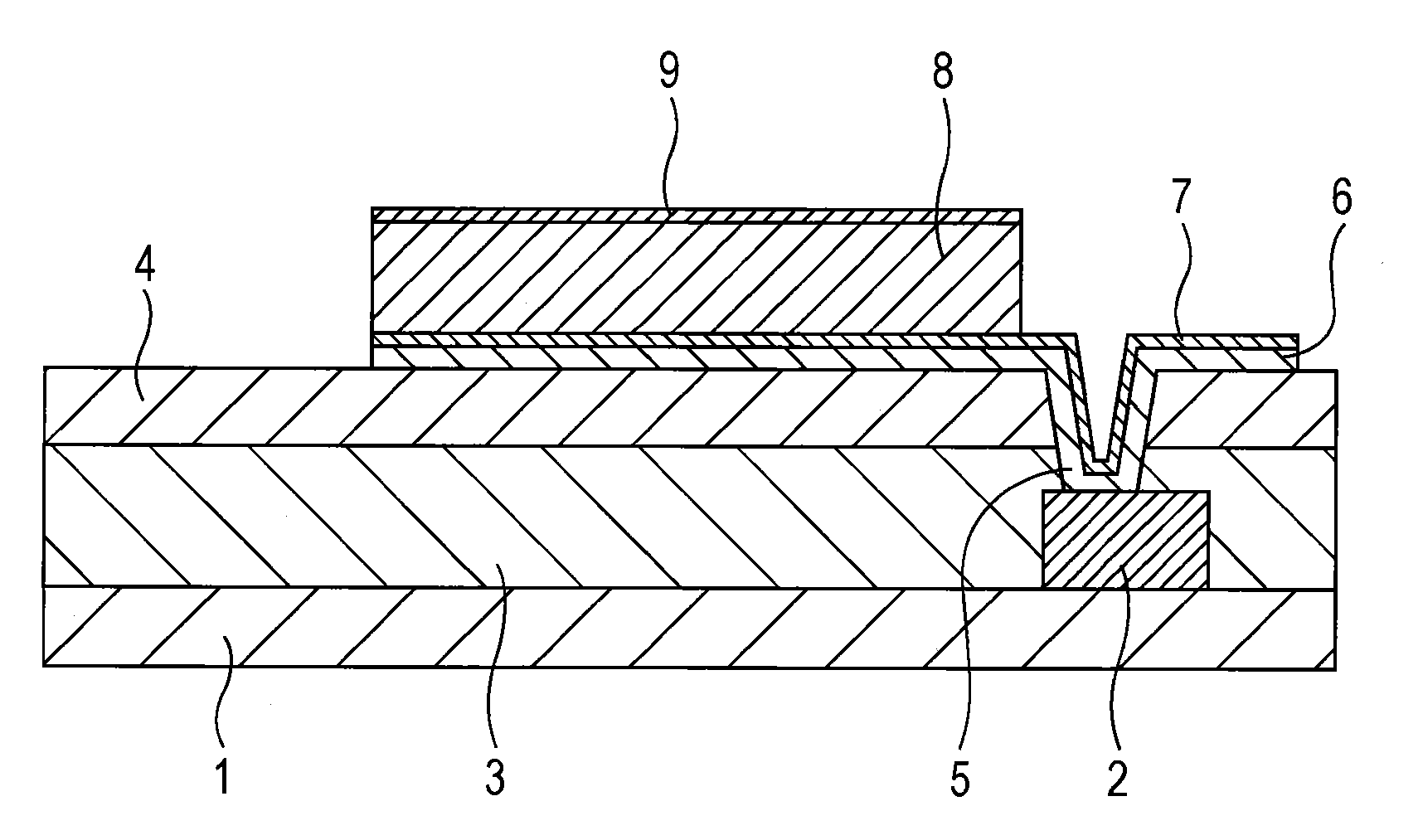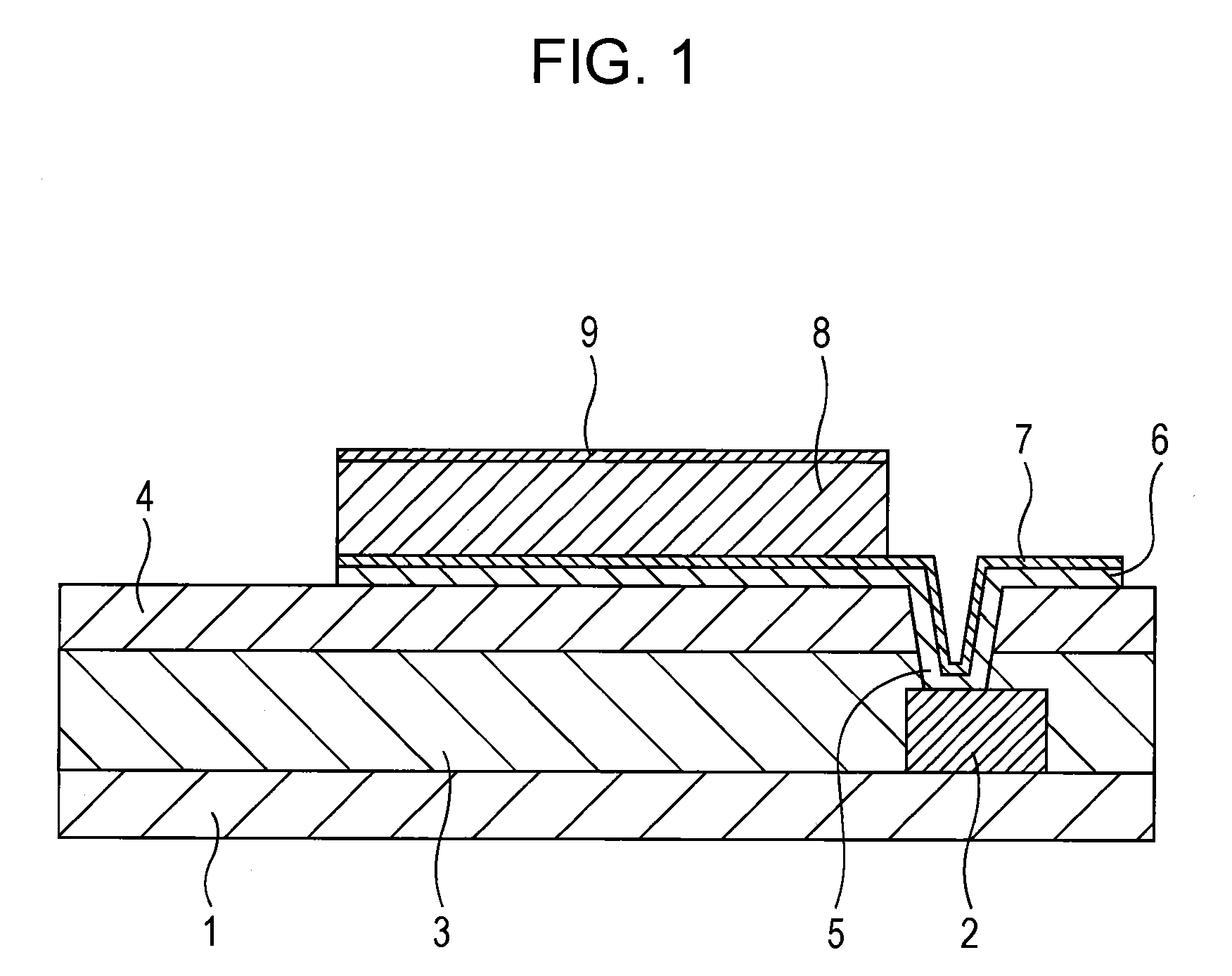Reflective anode electrode for organic el display
a technology of anode electrode and organic el, which is applied in the direction of solid-state devices, diaphragms, metallic material coating processes, etc., can solve the problems of increasing the number of tfts, increasing the influence of such obstacles, and low contact resistance, and achieving high reflectance. , the effect of low contact resistan
- Summary
- Abstract
- Description
- Claims
- Application Information
AI Technical Summary
Benefits of technology
Problems solved by technology
Method used
Image
Examples
example 1
[0084]In this example, various kinds of Al alloy reflective films were used and studies were made in order to examine how performing no heat treatment (Group A, Table 1) or performing post-annealing (Group B, Table 2) would affect the work function, the reflectance and the electrical resistivity, as well as the heat resistance, which is a property achieved according to a preferred embodiment of the invention.
[0085]First, an alkali-free glass plate (plate thickness: 0.7 mm) as a substrate was provided, and a SiN passivation film (film thickness: 300 nm) was formed on the surface of the substrate with a plasma CVD apparatus. The film production conditions were substrate temperature: 280° C., gas ratio: SiH4 / NH3 / N2=125 / 6 / 185, pressure: 137 Pa, and RF power: 100 W. On the surface of the passivation film, an Al alloy film which was a reflective film (film thickness: about 100 nm) was formed by a sputtering method. The compositions of the Al alloy films are described in Tables 1 and 2. Th...
example 2
[0108]In this example, Al alloy reflective films having the same compositions as in EXAMPLE 1 were used and studies were made in order to examine how performing pre-annealing and alkaline solution treatment (Group C, Table 3) or performing pre-annealing, alkaline solution treatment and post-annealing (Group D, Table 4) would affect the work function, the reflectance, the electrical resistivity and the contact resistance, as well as the heat resistance and the alkali corrosion resistance, which are properties achieved according to a preferred embodiment of the invention.
[0109]First, reflective films were produced in the same manner as described in EXAMPLE 1. The produced reflective films were grouped into Group C and Group D. The films belonging to Group C were heat treated (pre-annealed) at 250° C. for 30 minutes in a nitrogen atmosphere and were thereafter subjected to an alkaline solution treatment (a TMAH treatment) in which the films were soaked in an alkaline solution that was ...
example 3
[0120]In this example, the influence of the thickness of ITO film on the reflectance was studied.
[0121]In detail, reflective films were produced in the same manner as described in EXAMPLE 1, grouped into Group A and Group B, and treated in the same manner as described in EXAMPLE 1. The thickness of the ITO film was varied from 5 to 50 nm by changing the sputtering time. For comparison, similar processing was performed using a pure Al film or an Al-0.6% by atom Nd which was a simulated alloy film according to PTL 1.
[0122]The reflective anode electrodes manufactured as described above were tested in the same manner as described in EXAMPLE 1 in order to evaluate the reflectance. The results are described in Tables 5 and 6.
TABLE 5Composition ofITO filmPost-Reflect-No.reflective film*Groupthicknessannealingance1Pure AlA 5 nmNoA2Pure AlA10 nmNoA3Pure AlA30 nmNoB4Pure AlA50 nmNoC5Al—0.6NdA 5 nmNoA6Al—0.6NdA10 nmNoA7Al—0.6NdA30 nmNoB8Al—0.6NdA50 nmNoC9Al—0.6AgA 5 nmNoA10Al—0.6AgA10 nmNoA11A...
PUM
| Property | Measurement | Unit |
|---|---|---|
| thickness | aaaaa | aaaaa |
| thickness | aaaaa | aaaaa |
| thickness | aaaaa | aaaaa |
Abstract
Description
Claims
Application Information
 Login to View More
Login to View More - R&D
- Intellectual Property
- Life Sciences
- Materials
- Tech Scout
- Unparalleled Data Quality
- Higher Quality Content
- 60% Fewer Hallucinations
Browse by: Latest US Patents, China's latest patents, Technical Efficacy Thesaurus, Application Domain, Technology Topic, Popular Technical Reports.
© 2025 PatSnap. All rights reserved.Legal|Privacy policy|Modern Slavery Act Transparency Statement|Sitemap|About US| Contact US: help@patsnap.com


